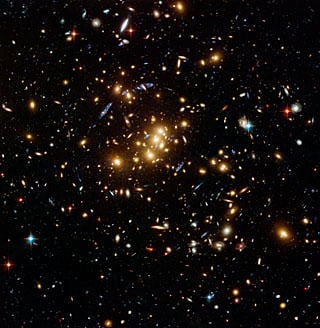[/caption] The first stars to light the early universe may have been powered by dark matter, according to a
new study.
Researchers from the University of Michigan, Ann Arbor call these very first stars "Dark Stars," and propose that dark matter heating provided the energy for these stars instead of fusion. The researchers propose that with a high concentration of dark matter in the early Universe, the theoretical particles called Weakly Interacting Massive Particles(WIMPs), collected inside the first stars and annihilated themselves to produce a heat source to power the stars. "We studied the behavior of WIMPs in the first stars," said Katherine Freese and her team in
their paper,
"and found that they can radically alter the stellar evolution. The annihilation products of the dark matter inside the star can be trapped and deposit enough energy to heat the star and prevent it from further collapse."
The philosophy behind this research is that 95% of the mass in galaxies and clusters of galaxies is in the form of an unknown type of matter and energy. The researchers say, "The first stars to form in the universe are a natural place to look for significant amounts of dark matter annihilation, because they form at the right place and the right time. They form at high redshifts, when the universe was still substantially denser than it is today, and at the high density centers of dark matter haloes."
The concentration of dark matter at that time would have been extremely high meaning that any ordinary stars would naturally contain large amounts of dark matter.
Dark stars would have been driven by the annihilation of dark matter particles releasing heat but only in stars larger than 400 solar masses. That turns out to be quite feasible since stars containing smaller amounts of dark matter would naturally grow as they swept up dark matter from nearby space.
The stars continued, and may still continue to be powered by dark matter annihilation as long as there is dark matter for fuel. When the dark matter runs out, they simply collapse to form black holes.
If they exist, Dark Stars should be able to be detected with future telescopes, and if found, would enable the study of WIMPs, and therefore be able to prove the existence of dark matter.
Sources:
arXiv
,
arXiv blog
 Universe Today
Universe Today
